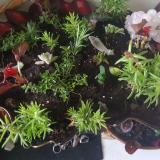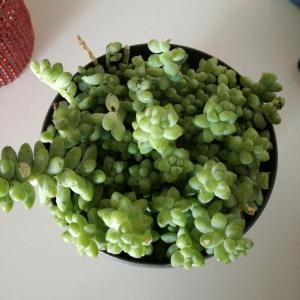文章
小马奥
2017年05月23日

Who do not love butterflies and making a butterfly container garden is a great way to invite beautiful butterflies fluttering across your urban garden.
Butterflies visit a garden for two things: In search of food (nectar) which they get from butterfly friendly flowers and for host plants to lay their eggs. So if you are making a butterfly garden, ensure you grow both butterfly friendly flowers that are nectar rich and host plants, type of plants that caterpillars prefer to eat.
Making a Butterfly Garden in Containers

Choose a right location
Usually, butterfly prefers to flutter in a sunny location that is less windy. For a butterfly container garden choose a location that receives at least 6 hours of sunlight daily and remains less windy.
Grow butterfly friendly plants
Grow nectar plants in containers to attract butterflies. Wildflowers and weeds and flowers of non-hybrid varieties are suitable. Also, choose plants that have long blooming season. Mums, yarrow, queen Anne’s lace, gaura, lantana, nemesia, zinnia, lavender, petunia, marigold, cosmos, verbena, butterfly weed, and pentas.
Plant host plants
Growing host plants when making a butterfly garden is important too. Host plants will attract the butterflies, they will lay the eggs on the bottom of their leaves, which will later become the caterpillar and feed on host plants. You can grow black eyed susan, common milkweed, asters, coneflowers, hollyhock, nasturtiums, herbs like dill and fennel and climbers like passionflower vine.
Arrange Plants at a different height

Arrange plants that at a different height. A combination of low-growing flowers, tall shrubs and trailing plants would be great. You can also apply the thriller-spiller-filler technique.
Plant densely and grow flowers in masses
Pollinators attract towards the areas where plants are planted densely and flowers appear in masses as they prefer to flutter from flower to flower.
Also Read: How to Make a Bee Friendly Garden
Flower color matters

Do you know butterflies can see colors and they attract more towards bold and warm colors: Yellow, pink, red, purple, lavender, bluish green or orange. Also, the flowers that bloom in clusters, short tubular flowers or those with large flat petals
lures them.
Do mulching with leaves
Some butterfly species lay eggs and hibernate in the covering of leaf litter or mulch to save themselves from predators, you can do thick mulching on each pot to help them.
Obtain a puddling source
You often see butterflies on moist sand or mud and it looks like they are nibbling something. This behavior is called puddling, they do this to obtain the minerals from the soil. You can create a puddling place in your butterfly container garden by placing a saucer or shallow pan, filling it with coarse moist sand. You can also add salt ½ to ¾ cup (table salt or rock salt) to 1 gallon of sand, mix it well and keep the sand evenly moist or wet all the time.
Avoid the use of chemical pesticides and herbicides
If you’re making a butterfly garden, you must know the use of pesticides discourage the pollinators and kill them too. So avoid using them. Instead, introduce beneficial insects like ladybugs, praying mantis and lacewings and use organic solutions.
Apply pesticides in evening or night
To save beneficial insects and pollinators like bees and butterflies it is best to apply pesticides in the evening or night when they are not active.
Butterflies visit a garden for two things: In search of food (nectar) which they get from butterfly friendly flowers and for host plants to lay their eggs. So if you are making a butterfly garden, ensure you grow both butterfly friendly flowers that are nectar rich and host plants, type of plants that caterpillars prefer to eat.
Making a Butterfly Garden in Containers

Choose a right location
Usually, butterfly prefers to flutter in a sunny location that is less windy. For a butterfly container garden choose a location that receives at least 6 hours of sunlight daily and remains less windy.
Grow butterfly friendly plants
Grow nectar plants in containers to attract butterflies. Wildflowers and weeds and flowers of non-hybrid varieties are suitable. Also, choose plants that have long blooming season. Mums, yarrow, queen Anne’s lace, gaura, lantana, nemesia, zinnia, lavender, petunia, marigold, cosmos, verbena, butterfly weed, and pentas.
Plant host plants
Growing host plants when making a butterfly garden is important too. Host plants will attract the butterflies, they will lay the eggs on the bottom of their leaves, which will later become the caterpillar and feed on host plants. You can grow black eyed susan, common milkweed, asters, coneflowers, hollyhock, nasturtiums, herbs like dill and fennel and climbers like passionflower vine.
Arrange Plants at a different height

Arrange plants that at a different height. A combination of low-growing flowers, tall shrubs and trailing plants would be great. You can also apply the thriller-spiller-filler technique.
Plant densely and grow flowers in masses
Pollinators attract towards the areas where plants are planted densely and flowers appear in masses as they prefer to flutter from flower to flower.
Also Read: How to Make a Bee Friendly Garden
Flower color matters

Do you know butterflies can see colors and they attract more towards bold and warm colors: Yellow, pink, red, purple, lavender, bluish green or orange. Also, the flowers that bloom in clusters, short tubular flowers or those with large flat petals
lures them.
Do mulching with leaves
Some butterfly species lay eggs and hibernate in the covering of leaf litter or mulch to save themselves from predators, you can do thick mulching on each pot to help them.
Obtain a puddling source
You often see butterflies on moist sand or mud and it looks like they are nibbling something. This behavior is called puddling, they do this to obtain the minerals from the soil. You can create a puddling place in your butterfly container garden by placing a saucer or shallow pan, filling it with coarse moist sand. You can also add salt ½ to ¾ cup (table salt or rock salt) to 1 gallon of sand, mix it well and keep the sand evenly moist or wet all the time.
Avoid the use of chemical pesticides and herbicides
If you’re making a butterfly garden, you must know the use of pesticides discourage the pollinators and kill them too. So avoid using them. Instead, introduce beneficial insects like ladybugs, praying mantis and lacewings and use organic solutions.
Apply pesticides in evening or night
To save beneficial insects and pollinators like bees and butterflies it is best to apply pesticides in the evening or night when they are not active.
0
1
文章
粉团
2017年05月23日

If you’re looking for an easy and most amazing way to transform your garden then use garden Pebbles!

Are you looking for a quick option to transform your garden and make it beautiful and attractive for visitors? If yes, then garden pebbles are the best options that you can opt for. One of the most important things about these is that regardless of what you do, your garden will always look remarkably beautiful and pleasant.
In the market, you can find varied, affordable and colorful garden pebbles. And there are many eye-catching and creative ways out there to use them. The best part is that these are very easy to maintain. For taking it to a whole new level and to increase the appeal of your garden and landscaping, you can opt for river rocks.
Why You Should Use Garden Pebbles
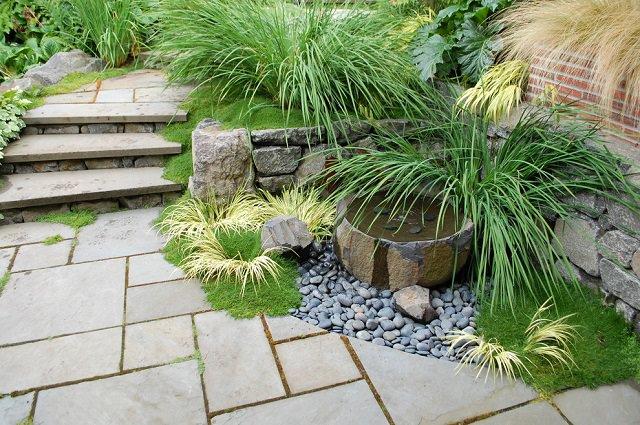
These are pleasant to look at and add a wide range of natural colors to the garden, thus, making your garden look more natural. It helps to maintain the original look and enhances the beauty of your garden. Some of the more notable benefits are:
These pebbles or stones are durable and can withstand almost any level of natural temperature. They are also effective for areas around the stove or fireplace as these are natural stones and resistant to most natural elements.You can also use them for mulching and if you have a container garden pebbles can make your container plants look better.The surfaces of the garden pebbles are flush and these are very safe to walk on. These stones offer more traction and as a result, slipping is out of the question with these stones in place.These stones can be used on dry surfaces such as on a plain landscape and also wet surfaces like a garden floor, swimming pool and portions of your deck.Useful Advice on Grouting Pebbles
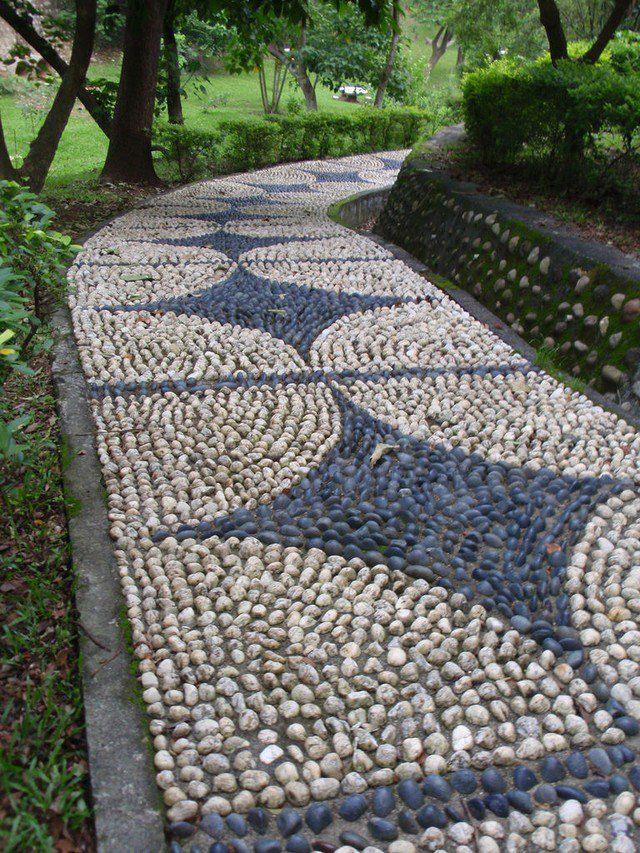
When you prepare the grout for placing the garden pebbles make sure that you avoid putting too much of water because adding a lot of water can result in a weak grout that can flake in later stages.In order to appreciate the beauty of these naturally attractive stones, you need to remove the excess grout with the help of a wet sponge. This is important because in order to make the setting beautiful you want to show as much stone as possible.In order to maintain the beauty of these natural stones, you need to make sure to apply sealant every 2-3 years so that the beauty can be prolonged.
Installing or using garden pebbles in your property all by yourself is a fun and creative activity. However, you need to make sure that you follow a proper procedure that will help to get everything done in the right way. If you are not good with working on grout and don’t have many creative ideas then it is best to call the professionals to help you in this regard.
Get Affordable Rates

There are a lot of things that you can buy to get your garden pebbles installed and there are many sellers available in the market. However, you need to make sure that you only buy from affordable sellers and get the best deals in this regard. Since there are multitudes of sellers in the market there is a lot of competition; and as a result, you can get attractive garden pebbles at the most affordable rates.
So, make sure that you compare all your options and then decide on the one that is most suitable for your needs. Get the help of the internet to understand the various possibilities that you have with these stones.

Are you looking for a quick option to transform your garden and make it beautiful and attractive for visitors? If yes, then garden pebbles are the best options that you can opt for. One of the most important things about these is that regardless of what you do, your garden will always look remarkably beautiful and pleasant.
In the market, you can find varied, affordable and colorful garden pebbles. And there are many eye-catching and creative ways out there to use them. The best part is that these are very easy to maintain. For taking it to a whole new level and to increase the appeal of your garden and landscaping, you can opt for river rocks.
Why You Should Use Garden Pebbles

These are pleasant to look at and add a wide range of natural colors to the garden, thus, making your garden look more natural. It helps to maintain the original look and enhances the beauty of your garden. Some of the more notable benefits are:
These pebbles or stones are durable and can withstand almost any level of natural temperature. They are also effective for areas around the stove or fireplace as these are natural stones and resistant to most natural elements.You can also use them for mulching and if you have a container garden pebbles can make your container plants look better.The surfaces of the garden pebbles are flush and these are very safe to walk on. These stones offer more traction and as a result, slipping is out of the question with these stones in place.These stones can be used on dry surfaces such as on a plain landscape and also wet surfaces like a garden floor, swimming pool and portions of your deck.Useful Advice on Grouting Pebbles

When you prepare the grout for placing the garden pebbles make sure that you avoid putting too much of water because adding a lot of water can result in a weak grout that can flake in later stages.In order to appreciate the beauty of these naturally attractive stones, you need to remove the excess grout with the help of a wet sponge. This is important because in order to make the setting beautiful you want to show as much stone as possible.In order to maintain the beauty of these natural stones, you need to make sure to apply sealant every 2-3 years so that the beauty can be prolonged.
Installing or using garden pebbles in your property all by yourself is a fun and creative activity. However, you need to make sure that you follow a proper procedure that will help to get everything done in the right way. If you are not good with working on grout and don’t have many creative ideas then it is best to call the professionals to help you in this regard.
Get Affordable Rates

There are a lot of things that you can buy to get your garden pebbles installed and there are many sellers available in the market. However, you need to make sure that you only buy from affordable sellers and get the best deals in this regard. Since there are multitudes of sellers in the market there is a lot of competition; and as a result, you can get attractive garden pebbles at the most affordable rates.
So, make sure that you compare all your options and then decide on the one that is most suitable for your needs. Get the help of the internet to understand the various possibilities that you have with these stones.
3
2
文章
lenny
2017年05月23日
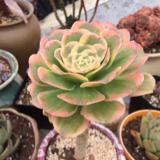
If you want to create a garden on terrace or you already own one, inspire yourself with these 21 ‘Beautiful Terrace Garden Images’.
To make a beautiful terrace garden, arrange everything neatly, do not use more than 3-5 colors on your terrace. Plan everything on paper, determine a theme and the ambiance you would like to create there and work accordingly.
1.
Create an alluring container garden on terrace, grow flowers to embellish it. Most of the terraces are sunny and flowers are easy to grow. Make a lovely flower garden with combination of both perennials and annuals equally.
2.
If you want to create a serene and calm garden on terrace, use colors like blue, green, indigo, pink and white instead of bright colors.
3.
Grow lot of vines and dwarf trees near the walls. These will use your vertical space efficiently.
4.
Create a low maintenance garden on terrace, if you are unable to do lot of care. Read these low maintenance garden tips.
5.
If you want to make a lush green garden, grow lot of dwarf conifers and ferns on your terrace. These will give an elegant look with wooden deck and furniture.
6.
This garden on terrace is simple yet good looking, not so many colors and accessories are used.
7.
Excellent use of old tires you can see here, these planters are made after doing some DIY hacks. See these DIY tire ideas for more.
8.
Both lavender and allium (ornamental onion) love sunny spot and well drained soil, growing them on terrace is easy too.
9.
Floor plays an essential role in creating a beautiful terrace garden. You can also use pebbles to add an extra element.
10.
Making a lawn on terrace is possible too. You’ll have your best seating place above your urban dwelling, if you’ll create a terrace lawn.
11.
Create a cottage garden like setup, wild and overgrown terrace garden that will give you peace of mind. In the garden you can white nicotianas are grown for scent and lavender in other corner with lot of perennials capturing the eyes. You can see more about this on Gardenista.
12.
What’s not you can do on your terrace? Make a water garden, if you love to grow aquatic plants.
13.
If you have a north or east facing terrace, you do not receive full sun. In that case grow plants that grows well in partial sun. Ferns, Ivies, violets and pansies are good choice for such terrace gardens.
14.
Make raised beds on your terrace to grow trees, this is a good idea if you want to grow large shrubs or trees that have deep roots.
15.
Classy and elegant, deck tiles are looking beautiful on this terrace in the evening. If you don’t want to grow lot of plants on your terrace, simply put some potted plants in the corner.
16.
Make your beautiful terrace garden more zippy at night so you can savor your dinner there, do some lightning and you will all set to enjoy.
17.
Growing a lawn needs lots of maintenance and care and if you are worried about this, use synthetic grass, it is a good option for both terrace and balcony gardens.
18.
Using light colored furniture is a great idea to follow on terraces, because light colored furniture don’t heat up early.
19.
Grow dwarf trees and bamboos for terrace garden privacy.
20.
You can grow annuals under potted trees, this is a good idea for limited space like terrace.
21.
To make a beautiful terrace garden, arrange everything neatly, do not use more than 3-5 colors on your terrace. Plan everything on paper, determine a theme and the ambiance you would like to create there and work accordingly.
1.

Create an alluring container garden on terrace, grow flowers to embellish it. Most of the terraces are sunny and flowers are easy to grow. Make a lovely flower garden with combination of both perennials and annuals equally.
2.

If you want to create a serene and calm garden on terrace, use colors like blue, green, indigo, pink and white instead of bright colors.
3.

Grow lot of vines and dwarf trees near the walls. These will use your vertical space efficiently.
4.

Create a low maintenance garden on terrace, if you are unable to do lot of care. Read these low maintenance garden tips.
5.

If you want to make a lush green garden, grow lot of dwarf conifers and ferns on your terrace. These will give an elegant look with wooden deck and furniture.
6.

This garden on terrace is simple yet good looking, not so many colors and accessories are used.
7.

Excellent use of old tires you can see here, these planters are made after doing some DIY hacks. See these DIY tire ideas for more.
8.

Both lavender and allium (ornamental onion) love sunny spot and well drained soil, growing them on terrace is easy too.
9.

Floor plays an essential role in creating a beautiful terrace garden. You can also use pebbles to add an extra element.
10.

Making a lawn on terrace is possible too. You’ll have your best seating place above your urban dwelling, if you’ll create a terrace lawn.
11.

Create a cottage garden like setup, wild and overgrown terrace garden that will give you peace of mind. In the garden you can white nicotianas are grown for scent and lavender in other corner with lot of perennials capturing the eyes. You can see more about this on Gardenista.
12.

What’s not you can do on your terrace? Make a water garden, if you love to grow aquatic plants.
13.

If you have a north or east facing terrace, you do not receive full sun. In that case grow plants that grows well in partial sun. Ferns, Ivies, violets and pansies are good choice for such terrace gardens.
14.

Make raised beds on your terrace to grow trees, this is a good idea if you want to grow large shrubs or trees that have deep roots.
15.

Classy and elegant, deck tiles are looking beautiful on this terrace in the evening. If you don’t want to grow lot of plants on your terrace, simply put some potted plants in the corner.
16.

Make your beautiful terrace garden more zippy at night so you can savor your dinner there, do some lightning and you will all set to enjoy.
17.

Growing a lawn needs lots of maintenance and care and if you are worried about this, use synthetic grass, it is a good option for both terrace and balcony gardens.
18.

Using light colored furniture is a great idea to follow on terraces, because light colored furniture don’t heat up early.
19.

Grow dwarf trees and bamboos for terrace garden privacy.
20.

You can grow annuals under potted trees, this is a good idea for limited space like terrace.
21.

1
1
文章
Eyin Thor
2017年05月23日

Learn how to grow poppies in this article. Even if you don’t have a space for large flower beds, by growing poppies in pots you can still enjoy the colorful blooms of this stately flowering plant.

Beautiful and seemingly delicate, the poppies are the plants not particularly very easy to grow but the beauty of the flowering plant makes it a popular classic. Those who want to enjoy the intense blooms in their container gardens must grow poppies in pots.
Best Poppy Varieties
There are some of the varieties of poppies that are popular and can grow well in a pot:
Oriental poppy
Most of the oriental poppy cultivars have large strikingly beautiful flowers that usually appears in late spring to early summer in bright colors like orange and red. There are also softer colors of this perennial flowering plant: pink, white and purple, with or without a central spot.
Height: 0.40 to 1.20 m.
USDA Hardiness Zones: 2-9
Iceland poppy
Usually grown as an annual or biennial.This short living perennial is self-seeding and come year after year, does not like the hot summers. Lightly perfumed flowers appear from mid spring to mid summer in colors like yellow, orange, red, pink and white. Flowers of this cultivar fade slowly than other poppies.
Height: 0.30 to 0.6 m.
USDA Hardiness zones: 3-9
California poppy
The showy state flower of California is a short-lived perennial in warm temperate and subtropical climates (USDA Zone 8-10). If you want to grow poppy in a tropical climate, try California poppy, keeping the plant in partial shade in summer.
Height: 0.15 to 0.45 m.
USDA Zones: 6-10b
Shirley poppy
One of the most beautiful and delicate poppies. Shirley Poppy is the name given to an ornamental cultivar group derived from the European wild field poppy (Papaver rhoeas).
Height: up to 0.6 m
USDA Zones: 3-9, can be grown in zones 10 & 11 as annual but doesn’t tolerate tropical heat well.
Choosing a Pot
Growing poppies in pots is easy, the plant is best grown in a medium sized pot. As poppies don’t tolerate waterlogged soil, ensure the pot has sufficient drainage holes in the bottom so that the water will drain freely.
How to Grow PoppiesSowing Seeds and Planting
1. Poppy grows well from seeds. Make sure that you place the pot in a bright position after planting seeds as poppy seeds require light to germinate. Also, most of the poppies do not like being transplanted, so either choose a pot that biodegradable or plant seeds in the exact pot in which you wish to grow poppy plants later.
2. Disperse seeds by hand in the pot. As the poppy seeds are very small, gardeners often mix them with sand to achieve a more equitable distribution. This also helps to see where the seeds were sown.
3. Tamp the seeds lightly down on the soil so that they are covered by a very thin layer of soil or sand. This keeps the seeds in place and they’ll also get plenty of light for germination. Once the seeds are planted moisten the soil making sure you don’t move the seeds.
4. Keep the soil constantly moist until germination. Germination depends on the climate and species but usually occurs within 25 days.
5. Poppies have a very delicate root system in the beginning so once the seedlings sprout water them gently. Thin out the seedlings 4-6 inches apart, when they reach a height of 5 inches. If you are planting in a medium to the large sized pot you can easily keep more than one plant per pot.
Requirements for Growing Poppies in Pots

Location
Poppies love the sun, so place your pots in a spot that receives ample sunlight, at least 6-7 hours daily. However, if you live in a warm climate where the sun is intense, grow poppies in partial sun.
Soil
Poppies can thrive on a variety of soils unless it is clay rich and blocks the drainage, the best is to use humus rich, loamy potting mix. The substrate should be neither too loose, nor prone to compaction and must be well draining. Slightly acidic to neutral soil pH is recommended.
Watering
When the poppies are in bloom or about to bloom in warm season, watering must be moderate and regular. On the contrary, once you get past the period of flowering, best to leave the soil dry as much as possible and watering must be done only when the top one inch surface of soil seems dry.
Poppy Plant Care
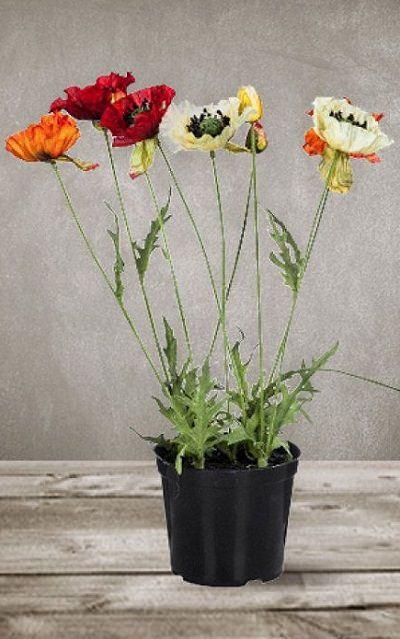
Fertilizer
Poppies are not heavy feeders; on the ground, they tolerate poor soil and thrive on their own but when growing poppies in pots you’ll need to fertilize the plant. At the time of planting or at the beginning of growing season, usually, spring (fall in warm frost-free climates), add a slow-release fertilizer to provide a steady supply of nutrition to plant during the whole season.
If you haven’t added a slow release fertilizer start to feed the plant with balanced liquid fertilizer on a bi-weekly basis once the plant has exceeded the height of 5 inches or when new growth emerges in spring. You can also feed the plant with flower fertilizer during the flowering period. Cease the application of fertilizer once the growing period ends.
Also, poppies are prone to magnesium and iron deficiency, application of Epsom salt is recommended.
Deadheading
Cut off the faded flowers to encourage more blooms.
Pests and Diseases
If the pot is not well draining or if you overwater the plant, it may die due to root rot. It also suffers from powdery mildew. In pests, keep an eye on aphids and spider mites.

Beautiful and seemingly delicate, the poppies are the plants not particularly very easy to grow but the beauty of the flowering plant makes it a popular classic. Those who want to enjoy the intense blooms in their container gardens must grow poppies in pots.
Best Poppy Varieties
There are some of the varieties of poppies that are popular and can grow well in a pot:
Oriental poppy
Most of the oriental poppy cultivars have large strikingly beautiful flowers that usually appears in late spring to early summer in bright colors like orange and red. There are also softer colors of this perennial flowering plant: pink, white and purple, with or without a central spot.
Height: 0.40 to 1.20 m.
USDA Hardiness Zones: 2-9
Iceland poppy
Usually grown as an annual or biennial.This short living perennial is self-seeding and come year after year, does not like the hot summers. Lightly perfumed flowers appear from mid spring to mid summer in colors like yellow, orange, red, pink and white. Flowers of this cultivar fade slowly than other poppies.
Height: 0.30 to 0.6 m.
USDA Hardiness zones: 3-9
California poppy
The showy state flower of California is a short-lived perennial in warm temperate and subtropical climates (USDA Zone 8-10). If you want to grow poppy in a tropical climate, try California poppy, keeping the plant in partial shade in summer.
Height: 0.15 to 0.45 m.
USDA Zones: 6-10b
Shirley poppy
One of the most beautiful and delicate poppies. Shirley Poppy is the name given to an ornamental cultivar group derived from the European wild field poppy (Papaver rhoeas).
Height: up to 0.6 m
USDA Zones: 3-9, can be grown in zones 10 & 11 as annual but doesn’t tolerate tropical heat well.
Choosing a Pot
Growing poppies in pots is easy, the plant is best grown in a medium sized pot. As poppies don’t tolerate waterlogged soil, ensure the pot has sufficient drainage holes in the bottom so that the water will drain freely.
How to Grow PoppiesSowing Seeds and Planting
1. Poppy grows well from seeds. Make sure that you place the pot in a bright position after planting seeds as poppy seeds require light to germinate. Also, most of the poppies do not like being transplanted, so either choose a pot that biodegradable or plant seeds in the exact pot in which you wish to grow poppy plants later.
2. Disperse seeds by hand in the pot. As the poppy seeds are very small, gardeners often mix them with sand to achieve a more equitable distribution. This also helps to see where the seeds were sown.
3. Tamp the seeds lightly down on the soil so that they are covered by a very thin layer of soil or sand. This keeps the seeds in place and they’ll also get plenty of light for germination. Once the seeds are planted moisten the soil making sure you don’t move the seeds.
4. Keep the soil constantly moist until germination. Germination depends on the climate and species but usually occurs within 25 days.
5. Poppies have a very delicate root system in the beginning so once the seedlings sprout water them gently. Thin out the seedlings 4-6 inches apart, when they reach a height of 5 inches. If you are planting in a medium to the large sized pot you can easily keep more than one plant per pot.
Requirements for Growing Poppies in Pots

Location
Poppies love the sun, so place your pots in a spot that receives ample sunlight, at least 6-7 hours daily. However, if you live in a warm climate where the sun is intense, grow poppies in partial sun.
Soil
Poppies can thrive on a variety of soils unless it is clay rich and blocks the drainage, the best is to use humus rich, loamy potting mix. The substrate should be neither too loose, nor prone to compaction and must be well draining. Slightly acidic to neutral soil pH is recommended.
Watering
When the poppies are in bloom or about to bloom in warm season, watering must be moderate and regular. On the contrary, once you get past the period of flowering, best to leave the soil dry as much as possible and watering must be done only when the top one inch surface of soil seems dry.
Poppy Plant Care

Fertilizer
Poppies are not heavy feeders; on the ground, they tolerate poor soil and thrive on their own but when growing poppies in pots you’ll need to fertilize the plant. At the time of planting or at the beginning of growing season, usually, spring (fall in warm frost-free climates), add a slow-release fertilizer to provide a steady supply of nutrition to plant during the whole season.
If you haven’t added a slow release fertilizer start to feed the plant with balanced liquid fertilizer on a bi-weekly basis once the plant has exceeded the height of 5 inches or when new growth emerges in spring. You can also feed the plant with flower fertilizer during the flowering period. Cease the application of fertilizer once the growing period ends.
Also, poppies are prone to magnesium and iron deficiency, application of Epsom salt is recommended.
Deadheading
Cut off the faded flowers to encourage more blooms.
Pests and Diseases
If the pot is not well draining or if you overwater the plant, it may die due to root rot. It also suffers from powdery mildew. In pests, keep an eye on aphids and spider mites.
4
1
文章
Alicia
2017年05月22日

Iris are one of the most beautiful and low care flowers that is why they are gardener’s favorite and if you are growing them, learn about the iris companion plants.
There are hundreds of Iris species with different growing needs and if you want to plant iris and its companion plants, first you’ll need to know about the requirements of specific iris species you are growing.
Companion Plants for Iris
While choosing iris companion plants, experiment. Instead of focusing only on the plant’s health, consider about the plants that require similar growing conditions and complement the color and texture of irises you are growing.
Bearded Iris Companion Plants
Companion plants for tall, dwarf and other bearded iris are Columbine, sweet rocket, pyrethrum, blue salvia, coralbells and Narcissus. Lilies, hemerocallis hybrids, penstemons, phlox and chrysanthemums are also used in combination with irises. Some gardeners grow forsythia in poor soil with iris.
Japanese Iris Companion Plants
Japanese iris grows in moist soil, their soil requirement is similar to impatiens. You can grow them in moist to boggy soil. Grow moisture loving plants with Japanese iris like soft rush, tropical sage and impatiens if there is shade, you can also ferns and plants like hosta near it.
Siberian Iris Companion Plants
Siberian irises are cold hardy and low maintenance. They grow in full sun to part shade and thrive in wide range of soil, preferably moist. Grow siberian iris plants in clumps to create a beautiful color contrast with daylilies, marsh spurge, ornamental poppy, lady’s mantle and cranesbill.
Other Iris Companion Plants
Peonies are traditionally companions for irises. If you plant a garden with irises, peonies and roses it will look wonderful. One more plant is forsythia, forsythia not only helps the irises grow, but also provides the beautiful contrast of color. Forsythia flowers herald the arrival of spring and their yellow colored blooms are perfect match for reticulated iris that flowers in the spring as well.
There are hundreds of Iris species with different growing needs and if you want to plant iris and its companion plants, first you’ll need to know about the requirements of specific iris species you are growing.

Companion Plants for Iris
While choosing iris companion plants, experiment. Instead of focusing only on the plant’s health, consider about the plants that require similar growing conditions and complement the color and texture of irises you are growing.
Bearded Iris Companion Plants
Companion plants for tall, dwarf and other bearded iris are Columbine, sweet rocket, pyrethrum, blue salvia, coralbells and Narcissus. Lilies, hemerocallis hybrids, penstemons, phlox and chrysanthemums are also used in combination with irises. Some gardeners grow forsythia in poor soil with iris.
Japanese Iris Companion Plants
Japanese iris grows in moist soil, their soil requirement is similar to impatiens. You can grow them in moist to boggy soil. Grow moisture loving plants with Japanese iris like soft rush, tropical sage and impatiens if there is shade, you can also ferns and plants like hosta near it.
Siberian Iris Companion Plants
Siberian irises are cold hardy and low maintenance. They grow in full sun to part shade and thrive in wide range of soil, preferably moist. Grow siberian iris plants in clumps to create a beautiful color contrast with daylilies, marsh spurge, ornamental poppy, lady’s mantle and cranesbill.
Other Iris Companion Plants
Peonies are traditionally companions for irises. If you plant a garden with irises, peonies and roses it will look wonderful. One more plant is forsythia, forsythia not only helps the irises grow, but also provides the beautiful contrast of color. Forsythia flowers herald the arrival of spring and their yellow colored blooms are perfect match for reticulated iris that flowers in the spring as well.
0
1
求助
Amanda Lynn
2017年05月22日

My boyfriend bought me a beautiful succulant arrangement. I have identified all but this one. It resembles an elephant bush l, however the stem is a light green and the leaves have a very delicate fuzz on them. Is this typical of a young EB plant? Or, is this something else??
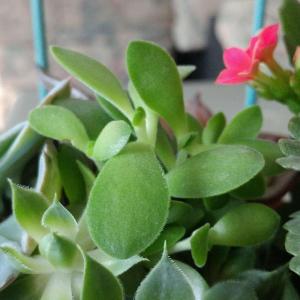

0
0
Amanda Lynn:Thank you so much! Im just starting to really get into gardening and I want to provide the best care to my little greenies that I can, but I need to know the species! lol
我是小花:The plant may be a Crassula rogersii, a polymeth, native to South Africa
文章
Juze
2017年05月22日

Guava tree care and growing is easy. With the information given in this article, you can understand how to grow guava tree in a pot. It will delight you with its sweetly scented flowers, delicious fruits, and beautiful tropical appearance.
USDA Hardiness Zones— 9 – 11, *can be grown in colder zones in pot
Difficulty— Easy
Other Names— Psidium guajava, Amrood, Amrut Phala, Araçá-Goiaba, Araçá-Guaçú, Banjiro, Brazilian Guava, Brazilian Red Guava, Common Guava, Fan Shi Liu, Feuille de Goyavier, Goiaba, Goiabeiro, Goyabe, Goyave, Goyave Jaune, Goyave Rouge, Goyavier, Goyavier du Brésil, Guaiaba, Guaiava, Guajava, Guava Leaf, Guava Leaves, Guava Peel, Guava Pulp, Guava Seed, Guava Seed Protein, Guavas, Guave, Guavenbaum, Guayaba, Guayabo, Guayave, Koejawel, Lemon Guava, Pépin de Goyave, Psidium, Psidium guajava, Pulpe de Goyave, Red Guava, Yellow Guava, Bihi

Guava Tree Information
Guava tree is a small tropical tree that grows 5-6 meters high on average, but if properly pruning it does not exceed the height of 3 m. It is a tough plant that can also be grown in containers.
Guava tree stems are tender when they are angled. The leaves are born in pairs, pale green, leathery and elongated, ending in the sharp tip with a length ranging between 10 and 20 cm and 8 cm wide. The flowers are borne at the base of the leaves, about 1-3 per node, in the younger branches with a great number of stamens and one pistil. Fruit shape, size, the color of flesh and skin usually depends on the variety. Maturity is observed when the shell reaches a yellowish-green, yellow, pink or pale color.
Also read: How to make Guava Bonsai
Best Guava Varieties
Over 100 varieties of guavas are identified in the world, different from each other by their flavor and appearance. Most of them can be grown in containers but we are listing some of the best.
Guava Ruby SupremeLucknow 49Psidium Guajava Nana (Dwarf Guava)Tikal GuavaRed Malaysian (Also grown for ornamental purposes)PatriciaIndonesian SeedlessIndonesian WhiteSafedaGuava Tree PropagationGrowing Guava from Cuttings
Guava is propagated from cuttings and seeds. Growing guava from cuttings require specific temperature and humidity, this method is suitable in warm climates.
Growing Guava from Seeds
Guava seeds are propagated easily with high germination rate. The main thing is that they must be fresh and obtained from the quality source. You can also use seed fresh seeds collected from the fruit but it is better to buy seeds from a seed store or online.
If you are using seeds obtained from guava fruit. Firstly, rinse them in soft water, which is not very cold then wrap the seeds in a cloth and dry them for a couple of hours. Then pour them in a cup of warm water and soak the seeds for 3-4 hours. Prepare a pot filled with seed starting mix, and sprinkle seeds in it. Now put the pot on a warm, well-lit spot, like a windowsill. To speed up germination, you can install a small plastic or cellophane over the top of a pot.
Guava tree grown from seeds take 3-4 years to mature and start to form fruits. From cuttings, it grows more quickly. However, our recommendation for you is to buy a grafted guava tree. Most of the grafted trees start to bear fruit in the same year and remain healthy.Planting Guava Tree
Choosing a pot
Guava tree grows large (around 30 feet) but in pots, it can be reduced to 2-3 m. Choose a pot that is at least 3 gallon (10 inches) to provide the plant a sufficient space to grow roots. *It is best to choose a clay pot with sufficient drainage holes in the bottom.
Also Read: How to Grow Pineapple Guava
Requirements for Growing Guava Tree in a PotLocation
Guava loves the sunny and warm exposure. It is a tropical plant but very much adaptable to temperate climates with moderate winter, when grown on the ground.
If you are growing guava in a container in tropics you can choose a location that receives shade in the afternoon and at least six hours of sun daily. In colder zones, place the plant in a spot that receives full sun for healthy growth and more fruiting.
Soil
For growing guava in pots choose a quality potting mix or make your own substrate using equal parts compost, sand, and soil.
Growing guava is possible in a variety of soil types. It is one of the plants that tolerates different soil types easily. It can be grown in heavy clay-rich or very sandy soil with pH ranging from 4.5 (acidic) to 9.4 (alkaline), but a loose, well-drained soil that is rich in organic matter and neutral to slightly acidic in pH is optimum.
When growing guava in a pot choose a self-pollinating variety.
Temperature range
The optimum temperature for germination of guavas falls in the range of 68 to 82 F (20 to 28 C). In winters, the temperature must not fall below 27 F (-3 C) for young guava trees. Mature guava tree (at least 3 years old) can bear temperature down to 20 F (-6 C). Remember, guavas are not frost tolerant, especially young plants, so if in a climate where the temperature falls below the range given here then it is better to keep the plant indoors until the temperature rises up.
Watering
When the plant is young or forming flowers water it regularly and deeply to keep the soil slightly moist. Evenly moist soil at the time of fruiting helps in developing more juicy and sweet fruits. In winter reduce the watering. One of the most interesting facts about guava trees is that they are drought tolerant and once established they can survive only on rainfall and bear long periods of drought. Still, it better to keep the soil slightly moist.
Guava Tree CareGuava tree care is simple and easy and with a few basic information, you can grow a healthy plant.Pruning
Pruning guava is essential to keep guava tree growing in a pot in desired shape and size to develop a strong structure, healthy plant and increased fruiting.
Dry, dead, damaged or diseased branches can be pruned anytime. The crowns grow naturally and well-branched and do not need regular cutting. Best is to cut back too long, unbranched shoots and branches that are crossing each other and blocking the penetration of sun rays after the harvest or at the beginning of growing season.
Fruit Thinning
Whenever the first time your guava tree blooms to form fruits it is better to deadhead the flowers, never allowing the fruits to set (do this if your plant is weak).
Allow no more than 4 fruits per branch. Also, thin out the fruits if they are developing on a small and weak branch.
Repotting
Repot the plant in one size bigger than the previous one. Never plant a plant in a too big pot directly, albeit change the pot time to time once the plant has outgrown the current one.
Fertilizer
Guava responds well to the monthly fertilizing. When the tree is young and is not bearing fruits, fertilize your potted guava tree with 6:6:6:2 [N P K Mg] to speed up the growth of the plant.
When the tree starts to bear fruits change the composition to 8:3:9:2 [N P K Mg].
Guava tree is also susceptible to iron deficiency (symptoms includes yellowing of the leaves in between the dark green veins). It can be corrected or prevented by periodic application chelated iron.
Mulching
Do mulching with organic matter so that the plant retains moisture. Mulching also helps in insulating the root of guava tree in winter.
Pests and Diseases
Guava tree care from pests and diseases is not much required when grown in a pot. This fruit tree is very tough but you should keep an eye on common garden pests. Mealy bugs, guava scale, white flies, fruit flies and thrips can affect it.
In diseases, guava plant suffers from rust, which occurs in too warm weather and high humidity.Besides this, anthracnose and leaf spot can be a problem too, both of these occurs in wet humid weather and spread through splashed water. By proper irrigation, you can easily prevent this.
Harvesting Guavas
Most of the guava tree varieties are self-pollinating and fruit ripens year round in tropics (except summer). Guava fruits usually mature in 3 to 4 months after flowering.
In India, generally, the main crop arrives in winter and after the summer in the rainy season. Winter crop is more flavorsome and sweet.
Uses
Guava fruits taste better when picked earlier than they fully mature. Fruits are highly nutritious, rich in vitamin C and can be eaten raw, its seeds are edible too. Ripened fruits can be used to make guava ice-cream, juice, jam, chutney, sauce or desserts.
A Few Guava Tree Care TipsDo not abruptly change the location of your potted guava tree otherwise the plant may lose leaves (partially).To get a bushy plant, it is necessary to pinch the growing tip regularly.It is advisable to suspend the fertilizer during the winters. In tropics, you can continue it.
USDA Hardiness Zones— 9 – 11, *can be grown in colder zones in pot
Difficulty— Easy
Other Names— Psidium guajava, Amrood, Amrut Phala, Araçá-Goiaba, Araçá-Guaçú, Banjiro, Brazilian Guava, Brazilian Red Guava, Common Guava, Fan Shi Liu, Feuille de Goyavier, Goiaba, Goiabeiro, Goyabe, Goyave, Goyave Jaune, Goyave Rouge, Goyavier, Goyavier du Brésil, Guaiaba, Guaiava, Guajava, Guava Leaf, Guava Leaves, Guava Peel, Guava Pulp, Guava Seed, Guava Seed Protein, Guavas, Guave, Guavenbaum, Guayaba, Guayabo, Guayave, Koejawel, Lemon Guava, Pépin de Goyave, Psidium, Psidium guajava, Pulpe de Goyave, Red Guava, Yellow Guava, Bihi

Guava Tree Information
Guava tree is a small tropical tree that grows 5-6 meters high on average, but if properly pruning it does not exceed the height of 3 m. It is a tough plant that can also be grown in containers.
Guava tree stems are tender when they are angled. The leaves are born in pairs, pale green, leathery and elongated, ending in the sharp tip with a length ranging between 10 and 20 cm and 8 cm wide. The flowers are borne at the base of the leaves, about 1-3 per node, in the younger branches with a great number of stamens and one pistil. Fruit shape, size, the color of flesh and skin usually depends on the variety. Maturity is observed when the shell reaches a yellowish-green, yellow, pink or pale color.
Also read: How to make Guava Bonsai
Best Guava Varieties
Over 100 varieties of guavas are identified in the world, different from each other by their flavor and appearance. Most of them can be grown in containers but we are listing some of the best.
Guava Ruby SupremeLucknow 49Psidium Guajava Nana (Dwarf Guava)Tikal GuavaRed Malaysian (Also grown for ornamental purposes)PatriciaIndonesian SeedlessIndonesian WhiteSafedaGuava Tree PropagationGrowing Guava from Cuttings
Guava is propagated from cuttings and seeds. Growing guava from cuttings require specific temperature and humidity, this method is suitable in warm climates.
Growing Guava from Seeds
Guava seeds are propagated easily with high germination rate. The main thing is that they must be fresh and obtained from the quality source. You can also use seed fresh seeds collected from the fruit but it is better to buy seeds from a seed store or online.
If you are using seeds obtained from guava fruit. Firstly, rinse them in soft water, which is not very cold then wrap the seeds in a cloth and dry them for a couple of hours. Then pour them in a cup of warm water and soak the seeds for 3-4 hours. Prepare a pot filled with seed starting mix, and sprinkle seeds in it. Now put the pot on a warm, well-lit spot, like a windowsill. To speed up germination, you can install a small plastic or cellophane over the top of a pot.
Guava tree grown from seeds take 3-4 years to mature and start to form fruits. From cuttings, it grows more quickly. However, our recommendation for you is to buy a grafted guava tree. Most of the grafted trees start to bear fruit in the same year and remain healthy.Planting Guava Tree

Choosing a pot
Guava tree grows large (around 30 feet) but in pots, it can be reduced to 2-3 m. Choose a pot that is at least 3 gallon (10 inches) to provide the plant a sufficient space to grow roots. *It is best to choose a clay pot with sufficient drainage holes in the bottom.
Also Read: How to Grow Pineapple Guava
Requirements for Growing Guava Tree in a PotLocation
Guava loves the sunny and warm exposure. It is a tropical plant but very much adaptable to temperate climates with moderate winter, when grown on the ground.
If you are growing guava in a container in tropics you can choose a location that receives shade in the afternoon and at least six hours of sun daily. In colder zones, place the plant in a spot that receives full sun for healthy growth and more fruiting.
Soil
For growing guava in pots choose a quality potting mix or make your own substrate using equal parts compost, sand, and soil.
Growing guava is possible in a variety of soil types. It is one of the plants that tolerates different soil types easily. It can be grown in heavy clay-rich or very sandy soil with pH ranging from 4.5 (acidic) to 9.4 (alkaline), but a loose, well-drained soil that is rich in organic matter and neutral to slightly acidic in pH is optimum.
When growing guava in a pot choose a self-pollinating variety.
Temperature range
The optimum temperature for germination of guavas falls in the range of 68 to 82 F (20 to 28 C). In winters, the temperature must not fall below 27 F (-3 C) for young guava trees. Mature guava tree (at least 3 years old) can bear temperature down to 20 F (-6 C). Remember, guavas are not frost tolerant, especially young plants, so if in a climate where the temperature falls below the range given here then it is better to keep the plant indoors until the temperature rises up.
Watering
When the plant is young or forming flowers water it regularly and deeply to keep the soil slightly moist. Evenly moist soil at the time of fruiting helps in developing more juicy and sweet fruits. In winter reduce the watering. One of the most interesting facts about guava trees is that they are drought tolerant and once established they can survive only on rainfall and bear long periods of drought. Still, it better to keep the soil slightly moist.
Guava Tree CareGuava tree care is simple and easy and with a few basic information, you can grow a healthy plant.Pruning
Pruning guava is essential to keep guava tree growing in a pot in desired shape and size to develop a strong structure, healthy plant and increased fruiting.
Dry, dead, damaged or diseased branches can be pruned anytime. The crowns grow naturally and well-branched and do not need regular cutting. Best is to cut back too long, unbranched shoots and branches that are crossing each other and blocking the penetration of sun rays after the harvest or at the beginning of growing season.
Fruit Thinning
Whenever the first time your guava tree blooms to form fruits it is better to deadhead the flowers, never allowing the fruits to set (do this if your plant is weak).
Allow no more than 4 fruits per branch. Also, thin out the fruits if they are developing on a small and weak branch.
Repotting
Repot the plant in one size bigger than the previous one. Never plant a plant in a too big pot directly, albeit change the pot time to time once the plant has outgrown the current one.
Fertilizer
Guava responds well to the monthly fertilizing. When the tree is young and is not bearing fruits, fertilize your potted guava tree with 6:6:6:2 [N P K Mg] to speed up the growth of the plant.
When the tree starts to bear fruits change the composition to 8:3:9:2 [N P K Mg].
Guava tree is also susceptible to iron deficiency (symptoms includes yellowing of the leaves in between the dark green veins). It can be corrected or prevented by periodic application chelated iron.
Mulching
Do mulching with organic matter so that the plant retains moisture. Mulching also helps in insulating the root of guava tree in winter.
Pests and Diseases
Guava tree care from pests and diseases is not much required when grown in a pot. This fruit tree is very tough but you should keep an eye on common garden pests. Mealy bugs, guava scale, white flies, fruit flies and thrips can affect it.
In diseases, guava plant suffers from rust, which occurs in too warm weather and high humidity.Besides this, anthracnose and leaf spot can be a problem too, both of these occurs in wet humid weather and spread through splashed water. By proper irrigation, you can easily prevent this.
Harvesting Guavas
Most of the guava tree varieties are self-pollinating and fruit ripens year round in tropics (except summer). Guava fruits usually mature in 3 to 4 months after flowering.
In India, generally, the main crop arrives in winter and after the summer in the rainy season. Winter crop is more flavorsome and sweet.
Uses
Guava fruits taste better when picked earlier than they fully mature. Fruits are highly nutritious, rich in vitamin C and can be eaten raw, its seeds are edible too. Ripened fruits can be used to make guava ice-cream, juice, jam, chutney, sauce or desserts.
A Few Guava Tree Care TipsDo not abruptly change the location of your potted guava tree otherwise the plant may lose leaves (partially).To get a bushy plant, it is necessary to pinch the growing tip regularly.It is advisable to suspend the fertilizer during the winters. In tropics, you can continue it.
0
0
文章
Abigal
2017年05月22日

Check out these 18 Flowering Ground Cover Plants, you’ll find some best low growing plants on this list, they’re not only easy to grow but looks beautiful too.1. Bigroot Geranium (Geranium macrorrhizum)
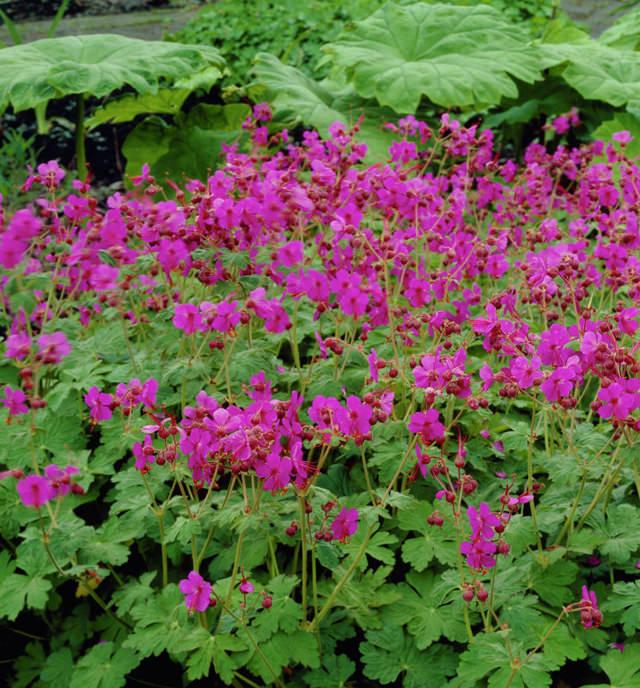
This old fashioned tough and aggressive perennial ground cover is a good choice for gardeners who want to grow low maintenance plants. The plant barely grows up to 1-1.5 feet tall and loves the sun. Blooms appear when the weather warms up in colors like pink, red or pale pink with interesting variegated foliage. You can also plant it in groups under the trees, the bigroot geranium is a drought tolerant plant and best grown in temperates under USDA Zones 4 to 8b.
2. Spotted Dead Nettle
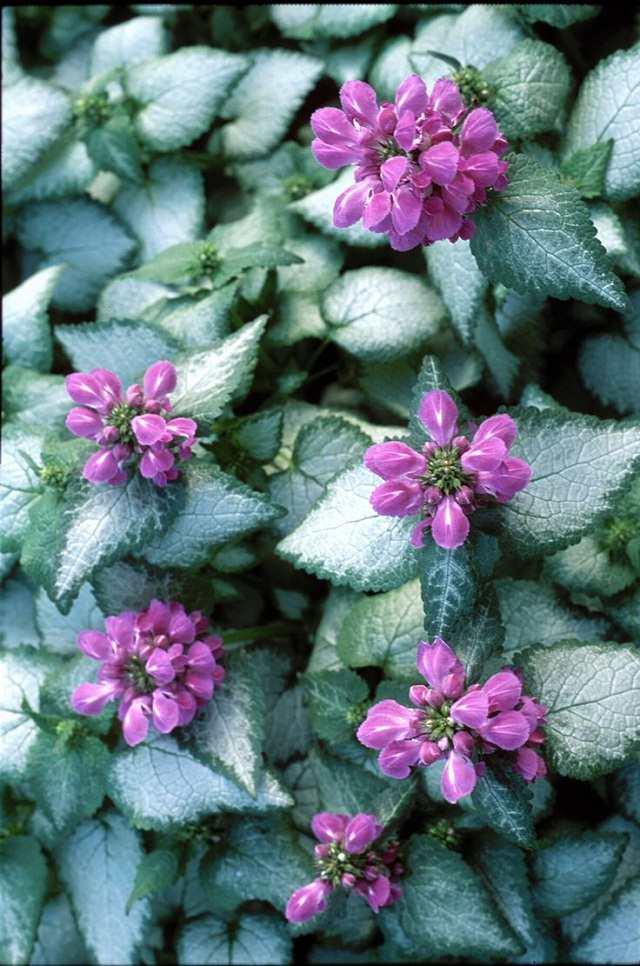
Dead nettle (Lamium maculatum) is notable for both its variegated foliage and its dense clusters of flowers, which appear in a variety of colors, including white, pink and purple (depending on the cultivar). This low growing plant can be grown diversely in different climates (USDA Zones 3-10), providing it cool, moist soil and shade to part shade. However, it must be noted that dead nettle can be invasive and considered as a weed by many gardeners.
3. Moss Rose (Portulaca)

This pretty little plant with needle-like foliage and tiny colorful flowers looks absolutely stunning. It is an annual or perennial (*in warm tropical and subtropical climates) ground cover that spreads densely. The blooms come in yellow, pink, red, white, orange and many more colors. Moss rose is very tolerant of poor conditions and dry soil.
4. Helianthemum

Also called ‘Sun Rose’ or ‘Rock Rose’, this subshrub comes from the family Cistaceae and barely grows up to 1 feet tall. Providing a well-drained soil and full sun (part shade in warmer climates) it blooms happily. The showy flowers of this genus come in shades of orange, pink, yellow, scarlet, and white. There are some varieties available that bloom for a long time from spring to fall (autumn). Grows in USDA Zones 5-9, this plant usually dies back in the colder regions when the winter perks up, whereas in warmer zones it remains evergreen.
5. Lilyturf (Liriope)

Lilyturf is neither a grass nor a lily. This showy and tough groundcover has lush and deep green, grass-like foliage ordered in slightly upright tufts. Spikes of violet or lavender color flowers appear from late summer until the fall.
Lilyturf (USDA Zones 6-10) requires full sun in colder regions but in warm subtropical or tropical climate, you can grow it in dappled shade. It can be grown between tall shrubs and underneath the canopy of trees, also use it for edging walkways or as and a low border accent. Liriope ‘Muscari’ and Liriope ‘Spicata’ are two most popular varieties.
6. Sweet Woodruff
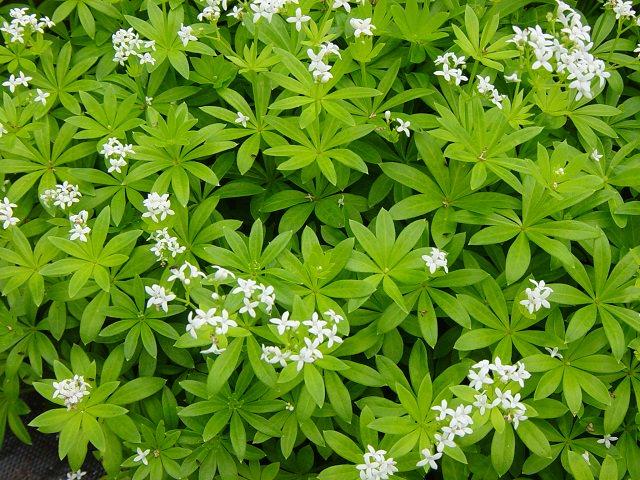
Sweet woodruff is an excellent ground cover if you want to add fragrance to your garden. Grows best in part shade to full shade and on well-drained soil, this plant can grow up to a height of only 8-10 inches (When in bloom). It starts to bloom prolifically from mid-spring, sweet woodruff leaves also release fragrance when crushed.
7. Creeping Thyme

Thymus serpyllum is a low-growing aromatic flowering herb that is perennial and hardy in USDA Zones 4-9. Just like other thyme varieties it is edible too. This tiny plant barely grows up to 3 inches tall. It is deer resistant and an amazing alternative of grasses.
8. Brass Button

If you’re searching for a lawn substitute on which you can set foot without thinking much then consider growing brass button. It also forms yellow-golden flowers that appear from spring to summer. Brass buttons are hardy in USDA Zones 5-10 (but evergreen only in Zone 8-10), growing in temperates to subtropical climates both.
9. Creeping Phlox
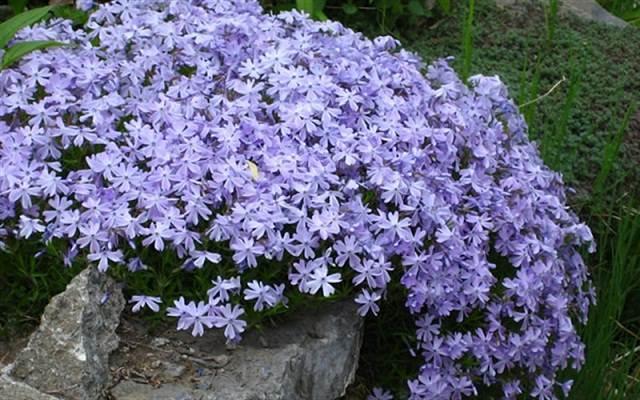
This ground cover has pleasant flowers that appear in pastel hues. Growing this sturdy, low-maintenance plant is possible in USDA Zones 3-8, it is the plant that can be used in landscaping to hide the unsightly slope or other difficult areas as it rambles between rocks or cascades down. It can also be used as a bordering plant around the flowerbeds.
10. Sedum

The genus ‘Sedum’ has a diverse group of ornamental succulent plants, you can grow low growing sedums as a ground cover in full sun and well-drained soil. Yellow flowers appear in summer. The best thing about sedums is there are about 400 species of them around the world that can be grown diversely in every climate.
11. Campanula Portenschlagiana

Campanula portenschlagiana or ‘Dalmatian Bellflower’ is a beautiful annual or perennial plant that forms a mat of small rounded leaves. The flowers are star-shaped, blue-purple in color that blooms from spring through summer. Relatively cold hardy but requires shelter when temperature dips below much. It grows in full sun and in the part shade too, on a fairly loose, well drained and alkaline soil.
12. Lily of the Valley

Lily of the Valley is one of the easiest and best flowering ground covers. Its fragrant little bell-shaped white flowers grow well in shade and have long blooming period. Growing lily of the valley plant is possible in cool temperate zones in USDA Zones 2-9.
13. Vinca minor
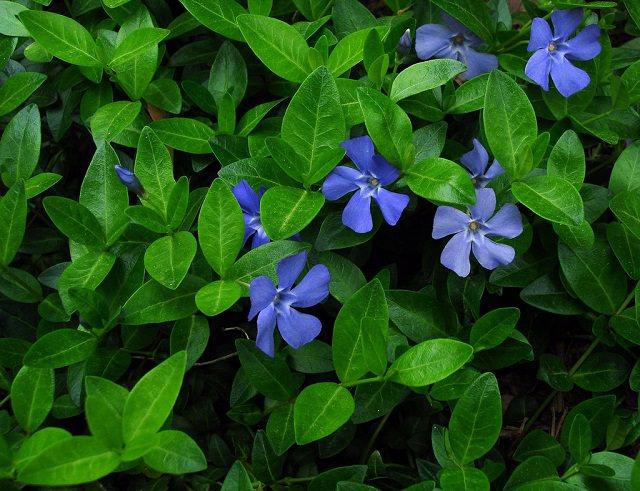
One of the most popular groundcovers, it is a hardy plant in both cold and warm climates under USDA Zones 4-10a that spreads quickly. It blooms prolifically, is easy to grow and tolerates poor soil and drought. Provide it full sun in the cold climate and part shade in warm climates.
14. Veronica ‘Goodness Grows’

This low growing beautiful perennial blooms from summer to fall. Good for country style or cottage style garden and also suitable for containers. With its spiky blue blooms, it looks good with bright green foliage. Veronica ‘Goodness Grows’ requires full sun and regular but moderate watering.
15. Firecracker (Russelia equisetiformis)
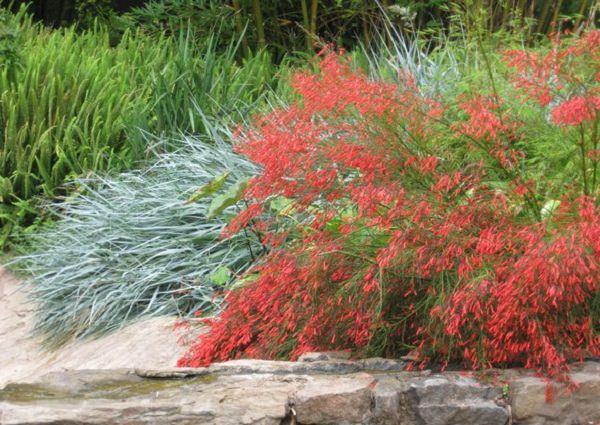
A warm climate plant that grows best in warm temperates, subtropics, and tropics (USDA Zones 8b-11). This drought tolerant plant is loved by nectar-feeding species of birds, and by butterflies. Fluffy, errant and wispy stems and foliage cascade down and camouflages the unsightly areas. It is suitable for slopes, borders, retaining walls and containers too.
16. Lamb’s Ear

One of the best flowering ground cover plants on our list due to its thick attractive silver-grey-green foliage that forms gentle and velvety rosettes, not only the foliage, its purple colored flowers that appear from late spring are appealing too. This excellent edging plant only grows up 12 inches tall in part sun to full sun under USDA Zones 4-9.
17. Society Garlic

Society garlic (Tulbaghia violacea) is also known as ‘Pink agapanthus’. With its edible garlic-flavored purple flowers and clump forming grass like blue-grey foliage, this tough and low maintenance ground cover is a good option for those who live in warmer climates. Suitable for warm temperates, subtropics and tropics under USDA Zones 7-11.
18. Ajuga

Ajuga, which is also called ‘Bugleweed’ is a genus of perennial or annual flowering plants. It becomes an excellent ground cover, sometimes invasive. Many of its species are very popular, especially ‘Ajuga reptans’ that spread through its runners, having attractive foliage that forms a dense carpet-like mat and deep blue flower spikes. It is possible to grow ajuga in both cold and warm climates (USDA Zones, 3-10).

This old fashioned tough and aggressive perennial ground cover is a good choice for gardeners who want to grow low maintenance plants. The plant barely grows up to 1-1.5 feet tall and loves the sun. Blooms appear when the weather warms up in colors like pink, red or pale pink with interesting variegated foliage. You can also plant it in groups under the trees, the bigroot geranium is a drought tolerant plant and best grown in temperates under USDA Zones 4 to 8b.
2. Spotted Dead Nettle

Dead nettle (Lamium maculatum) is notable for both its variegated foliage and its dense clusters of flowers, which appear in a variety of colors, including white, pink and purple (depending on the cultivar). This low growing plant can be grown diversely in different climates (USDA Zones 3-10), providing it cool, moist soil and shade to part shade. However, it must be noted that dead nettle can be invasive and considered as a weed by many gardeners.
3. Moss Rose (Portulaca)

This pretty little plant with needle-like foliage and tiny colorful flowers looks absolutely stunning. It is an annual or perennial (*in warm tropical and subtropical climates) ground cover that spreads densely. The blooms come in yellow, pink, red, white, orange and many more colors. Moss rose is very tolerant of poor conditions and dry soil.
4. Helianthemum

Also called ‘Sun Rose’ or ‘Rock Rose’, this subshrub comes from the family Cistaceae and barely grows up to 1 feet tall. Providing a well-drained soil and full sun (part shade in warmer climates) it blooms happily. The showy flowers of this genus come in shades of orange, pink, yellow, scarlet, and white. There are some varieties available that bloom for a long time from spring to fall (autumn). Grows in USDA Zones 5-9, this plant usually dies back in the colder regions when the winter perks up, whereas in warmer zones it remains evergreen.
5. Lilyturf (Liriope)

Lilyturf is neither a grass nor a lily. This showy and tough groundcover has lush and deep green, grass-like foliage ordered in slightly upright tufts. Spikes of violet or lavender color flowers appear from late summer until the fall.
Lilyturf (USDA Zones 6-10) requires full sun in colder regions but in warm subtropical or tropical climate, you can grow it in dappled shade. It can be grown between tall shrubs and underneath the canopy of trees, also use it for edging walkways or as and a low border accent. Liriope ‘Muscari’ and Liriope ‘Spicata’ are two most popular varieties.
6. Sweet Woodruff

Sweet woodruff is an excellent ground cover if you want to add fragrance to your garden. Grows best in part shade to full shade and on well-drained soil, this plant can grow up to a height of only 8-10 inches (When in bloom). It starts to bloom prolifically from mid-spring, sweet woodruff leaves also release fragrance when crushed.
7. Creeping Thyme

Thymus serpyllum is a low-growing aromatic flowering herb that is perennial and hardy in USDA Zones 4-9. Just like other thyme varieties it is edible too. This tiny plant barely grows up to 3 inches tall. It is deer resistant and an amazing alternative of grasses.
8. Brass Button

If you’re searching for a lawn substitute on which you can set foot without thinking much then consider growing brass button. It also forms yellow-golden flowers that appear from spring to summer. Brass buttons are hardy in USDA Zones 5-10 (but evergreen only in Zone 8-10), growing in temperates to subtropical climates both.
9. Creeping Phlox

This ground cover has pleasant flowers that appear in pastel hues. Growing this sturdy, low-maintenance plant is possible in USDA Zones 3-8, it is the plant that can be used in landscaping to hide the unsightly slope or other difficult areas as it rambles between rocks or cascades down. It can also be used as a bordering plant around the flowerbeds.
10. Sedum

The genus ‘Sedum’ has a diverse group of ornamental succulent plants, you can grow low growing sedums as a ground cover in full sun and well-drained soil. Yellow flowers appear in summer. The best thing about sedums is there are about 400 species of them around the world that can be grown diversely in every climate.
11. Campanula Portenschlagiana

Campanula portenschlagiana or ‘Dalmatian Bellflower’ is a beautiful annual or perennial plant that forms a mat of small rounded leaves. The flowers are star-shaped, blue-purple in color that blooms from spring through summer. Relatively cold hardy but requires shelter when temperature dips below much. It grows in full sun and in the part shade too, on a fairly loose, well drained and alkaline soil.
12. Lily of the Valley

Lily of the Valley is one of the easiest and best flowering ground covers. Its fragrant little bell-shaped white flowers grow well in shade and have long blooming period. Growing lily of the valley plant is possible in cool temperate zones in USDA Zones 2-9.
13. Vinca minor

One of the most popular groundcovers, it is a hardy plant in both cold and warm climates under USDA Zones 4-10a that spreads quickly. It blooms prolifically, is easy to grow and tolerates poor soil and drought. Provide it full sun in the cold climate and part shade in warm climates.
14. Veronica ‘Goodness Grows’

This low growing beautiful perennial blooms from summer to fall. Good for country style or cottage style garden and also suitable for containers. With its spiky blue blooms, it looks good with bright green foliage. Veronica ‘Goodness Grows’ requires full sun and regular but moderate watering.
15. Firecracker (Russelia equisetiformis)

A warm climate plant that grows best in warm temperates, subtropics, and tropics (USDA Zones 8b-11). This drought tolerant plant is loved by nectar-feeding species of birds, and by butterflies. Fluffy, errant and wispy stems and foliage cascade down and camouflages the unsightly areas. It is suitable for slopes, borders, retaining walls and containers too.
16. Lamb’s Ear

One of the best flowering ground cover plants on our list due to its thick attractive silver-grey-green foliage that forms gentle and velvety rosettes, not only the foliage, its purple colored flowers that appear from late spring are appealing too. This excellent edging plant only grows up 12 inches tall in part sun to full sun under USDA Zones 4-9.
17. Society Garlic

Society garlic (Tulbaghia violacea) is also known as ‘Pink agapanthus’. With its edible garlic-flavored purple flowers and clump forming grass like blue-grey foliage, this tough and low maintenance ground cover is a good option for those who live in warmer climates. Suitable for warm temperates, subtropics and tropics under USDA Zones 7-11.
18. Ajuga

Ajuga, which is also called ‘Bugleweed’ is a genus of perennial or annual flowering plants. It becomes an excellent ground cover, sometimes invasive. Many of its species are very popular, especially ‘Ajuga reptans’ that spread through its runners, having attractive foliage that forms a dense carpet-like mat and deep blue flower spikes. It is possible to grow ajuga in both cold and warm climates (USDA Zones, 3-10).
1
0
文章
Micky
2017年05月22日

Learn how to grow Ginko Biloba tree, growing ginkgo biloba tree is easy. This beautiful ornamental tree will soon become one of the most beautiful trees in your garden, once established.

USDA zones — 4-9
Other Names — Fossil Tree, Maidenhair Tree, Japanese Silver Apricot, Baiguo, Bai Guo Ye, Kew Tree, Yinhsing, The Tree of Forty Crowns
Difficulty — Easy
How to Grow Ginkgo Biloba Propagation
Ginkgo tree can be propagated from seeds or by cuttings.
Propagation from cuttings is better. To propagate it from cuttings, cut around 10 cm long cutting and plant it in a pot with potting soil lightened with perlite.
Cover it with plastic sheet and water regularly. After cutting has rooted, slowly acclimatize it without the sheet and transplant it into bigger pot or on the ground when it has outgrown the current pot.
Also Read: Ginkgo Biloba Tree Facts
Planting Ginkgo Biloba Tree
Female trees form fleshy fruits and their smell quickly becomes nauseating. Ether avoid planting them or plant them away from your home.
Plant ginkgo tree in the fall or spring. Prepare planting hole that is of the same depth and twice wide of the rootball. Bury the rootball in hole and water thoroughly. Protect young plants from drought and harsh sun.
Requirements for Growing Ginkgo Biloba TreePosition
It has good tolerance to the temperate climate and can withstand a semi-continental condition. It needs full sun or very light shade. It is also resistant to winds.
Soil
No specific soil type is required for growing ginkgo biloba tree. However, soil should be well drained but in a way that it must not dry out quickly, also note that the tree grows long taproot and requires deep soil.
It is best to plant it in light, rich soil. It supports mildly calcareous soil but prefers neutral, silty and slightly clayey soil. Add sand if needed to alleviate the heavy clay rich soil and compost to amend the poor substrate.
Watering
Water Ginkgo biloba tree regularly until it establishes in the first 3 years of growth. Keeping the soil moist as its growth is slower in dry soil but avoid damp and heavy soil.
Ginkgo Biloba Tree CareFertilizer
Generally, fertilizer is not required but to give a boost you can fertilize it in spring using a slow-release balanced fertilizer containing nitrogen, phosphorus and potassium (N-P-K), according to the label instructions. A balanced 10-10-10 fertilizer is suitable. Annual application of compost or manure is also helpful for plant.
Mulching
Mulching is essential for growing ginkgo biloba tree. In summer to preserve moisture and in winter to protect the roots from the cold.
Pruning
Ginkgo biloba is a beautiful tree, it does not require additional pruning unless you want to control its shape or size.
Pests and Diseases

USDA zones — 4-9
Other Names — Fossil Tree, Maidenhair Tree, Japanese Silver Apricot, Baiguo, Bai Guo Ye, Kew Tree, Yinhsing, The Tree of Forty Crowns
Difficulty — Easy
How to Grow Ginkgo Biloba Propagation
Ginkgo tree can be propagated from seeds or by cuttings.
Propagation from cuttings is better. To propagate it from cuttings, cut around 10 cm long cutting and plant it in a pot with potting soil lightened with perlite.
Cover it with plastic sheet and water regularly. After cutting has rooted, slowly acclimatize it without the sheet and transplant it into bigger pot or on the ground when it has outgrown the current pot.
Also Read: Ginkgo Biloba Tree Facts
Planting Ginkgo Biloba Tree
Female trees form fleshy fruits and their smell quickly becomes nauseating. Ether avoid planting them or plant them away from your home.
Plant ginkgo tree in the fall or spring. Prepare planting hole that is of the same depth and twice wide of the rootball. Bury the rootball in hole and water thoroughly. Protect young plants from drought and harsh sun.
Requirements for Growing Ginkgo Biloba TreePosition
It has good tolerance to the temperate climate and can withstand a semi-continental condition. It needs full sun or very light shade. It is also resistant to winds.
Soil
No specific soil type is required for growing ginkgo biloba tree. However, soil should be well drained but in a way that it must not dry out quickly, also note that the tree grows long taproot and requires deep soil.
It is best to plant it in light, rich soil. It supports mildly calcareous soil but prefers neutral, silty and slightly clayey soil. Add sand if needed to alleviate the heavy clay rich soil and compost to amend the poor substrate.
Watering
Water Ginkgo biloba tree regularly until it establishes in the first 3 years of growth. Keeping the soil moist as its growth is slower in dry soil but avoid damp and heavy soil.
Ginkgo Biloba Tree CareFertilizer
Generally, fertilizer is not required but to give a boost you can fertilize it in spring using a slow-release balanced fertilizer containing nitrogen, phosphorus and potassium (N-P-K), according to the label instructions. A balanced 10-10-10 fertilizer is suitable. Annual application of compost or manure is also helpful for plant.
Mulching
Mulching is essential for growing ginkgo biloba tree. In summer to preserve moisture and in winter to protect the roots from the cold.
Pruning
Ginkgo biloba is a beautiful tree, it does not require additional pruning unless you want to control its shape or size.
Pests and Diseases
1
0
文章
Abigal
2017年05月22日

Learn how to grow star anise in this article. Star anise is a spice widely used in South East Asian cuisines, growing star anise is easy in subtropical climates. It is adorned with beautiful flowers and fruits that are star shaped.
USDA Zones— 8 – 11
Difficulty— Moderate
Other Names— Anis de Chine, Anís Estrellado, Anis Étoilé, Anis Étoilé Chinois, Aniseed Stars, Anisi Stellati Fructus, Ba Jiao Hui, Badiana, Badiane, Badiane de Chine, Bajiao, Chinese Anise, Chinese Star Anise, Eight-Horned Anise, Eight Horns and Illicium verum.
It belongs to the family of Illiciaceae, dicotyledonous angiosperm species. It is a tropical evergreen tree, tall between 5-10 m. Star anise has large glossy green foliage, its white flowers are beautiful and of great decorative value. Star anise fruit has eight carpels that together form the star-shaped fruit (hence called “Star anise”).
Propagation
Star anise is propagated by seeds or cuttings. How to grow star anise from seed: Seeds are propagated best when temperature range around 65 – 70 F (18 – 20 C). You can sow seeds in pots and or directly outside.
Water the seeds frequently to keep the soil moist and make sure the pot has drainage holes in the bottom to drain excess water.
Growing Condition
Star anise is native to Vietnam and China and grows in warm subtropical climate. It is a frost tender perennial. Star anise only grows in areas where the temperature does not fall below 15 F (-10 C) . If you live in a cooler area below USDA Zone 9, plant star anise in a container so that you can keep it in a greenhouse or indoors in winter.
Requirements for Growing Star AnisePosition
Star anise requires dappled shade, partial sun but if you’re growing star anise in a much cooler climate, plant it in a warm and sunny location. Choose location in a way that it is not exposed to cold and dry winds.
Soil
Provide soil that is humus and compost rich. Soil texture should be loamy and well drained. Slightly acidic to neutral soil is optimal.
Watering
For growing star anise, do regular watering and keep the soil slightly moist but reduce the watering in winter.
Star Anise CareFertilizer
Spread a 3-inch layer of compost or aged manure on the ground surrounding the tree in the spring. This is the only fertilizer it requires.
If soil is poor, apply slow release fertilizer all purpose fertilizer in the spring.
Pruning
When the plant is young pinch and prune it if you want to make it bushier. There are no special pruning requirements, however, you can always prune off dead, diseased and weak branches.
Harvest
Star anise tree takes at least 6 years to fruit if grown from seeds. These fruits (wrongly called seeds) are picked unripe while they are still green, later on these fruits are sun dried until their color change to reddish-brown, seeds can be removed once the fruits are ready to be stored.
Pests and Diseases
There are not any specific pest or disease that bothers it. Star anise itself has anti bacterial and pest repellent properties.
Uses
Star Anise is widely used in Asian cuisines to flavor dishes especially meat and curries, it is also used in desserts and beverages. Together with fennel seeds, cloves, cinnamon and pepper it is considered as one of the “Five Chinese Spice”, used for its strong taste and spicy flavor. It is an essential part of Chinese cuisines and also used in variety of Indian recipes. It’s addition to other popular Indian spices makes a special spicy ingredient, which is called “Garam masala”.
Warnings
While growing star anise, don’t confuse it with Japanese star anise (Illicium anisatum) or “Shikimi“, which is a poisonous plant and native to Japan. Its seeds or fruits are somewhat similar to those of star anise and are only slightly smaller and looks like cardamom, having a more rounded shape and have a small hook.

USDA Zones— 8 – 11
Difficulty— Moderate
Other Names— Anis de Chine, Anís Estrellado, Anis Étoilé, Anis Étoilé Chinois, Aniseed Stars, Anisi Stellati Fructus, Ba Jiao Hui, Badiana, Badiane, Badiane de Chine, Bajiao, Chinese Anise, Chinese Star Anise, Eight-Horned Anise, Eight Horns and Illicium verum.
It belongs to the family of Illiciaceae, dicotyledonous angiosperm species. It is a tropical evergreen tree, tall between 5-10 m. Star anise has large glossy green foliage, its white flowers are beautiful and of great decorative value. Star anise fruit has eight carpels that together form the star-shaped fruit (hence called “Star anise”).
Propagation
Star anise is propagated by seeds or cuttings. How to grow star anise from seed: Seeds are propagated best when temperature range around 65 – 70 F (18 – 20 C). You can sow seeds in pots and or directly outside.
Water the seeds frequently to keep the soil moist and make sure the pot has drainage holes in the bottom to drain excess water.
Growing Condition
Star anise is native to Vietnam and China and grows in warm subtropical climate. It is a frost tender perennial. Star anise only grows in areas where the temperature does not fall below 15 F (-10 C) . If you live in a cooler area below USDA Zone 9, plant star anise in a container so that you can keep it in a greenhouse or indoors in winter.
Requirements for Growing Star AnisePosition
Star anise requires dappled shade, partial sun but if you’re growing star anise in a much cooler climate, plant it in a warm and sunny location. Choose location in a way that it is not exposed to cold and dry winds.
Soil
Provide soil that is humus and compost rich. Soil texture should be loamy and well drained. Slightly acidic to neutral soil is optimal.
Watering
For growing star anise, do regular watering and keep the soil slightly moist but reduce the watering in winter.
Star Anise CareFertilizer
Spread a 3-inch layer of compost or aged manure on the ground surrounding the tree in the spring. This is the only fertilizer it requires.
If soil is poor, apply slow release fertilizer all purpose fertilizer in the spring.
Pruning
When the plant is young pinch and prune it if you want to make it bushier. There are no special pruning requirements, however, you can always prune off dead, diseased and weak branches.
Harvest
Star anise tree takes at least 6 years to fruit if grown from seeds. These fruits (wrongly called seeds) are picked unripe while they are still green, later on these fruits are sun dried until their color change to reddish-brown, seeds can be removed once the fruits are ready to be stored.
Pests and Diseases
There are not any specific pest or disease that bothers it. Star anise itself has anti bacterial and pest repellent properties.
Uses
Star Anise is widely used in Asian cuisines to flavor dishes especially meat and curries, it is also used in desserts and beverages. Together with fennel seeds, cloves, cinnamon and pepper it is considered as one of the “Five Chinese Spice”, used for its strong taste and spicy flavor. It is an essential part of Chinese cuisines and also used in variety of Indian recipes. It’s addition to other popular Indian spices makes a special spicy ingredient, which is called “Garam masala”.
Warnings
While growing star anise, don’t confuse it with Japanese star anise (Illicium anisatum) or “Shikimi“, which is a poisonous plant and native to Japan. Its seeds or fruits are somewhat similar to those of star anise and are only slightly smaller and looks like cardamom, having a more rounded shape and have a small hook.
2
0
文章
Abigal
2017年05月22日

Learn how to grow gaura in your garden. Gaura plant care and growing is easy. This drought tolerant shrub thrives in well-drained soil and loves to bath in the day long sun.
The gaura is a beautiful perennial plant that is easy to grow and with minimal care, it offers a long blooming period and colorful flowers that attract butterflies.
Gaura Plant Care

USDA Zones— 5 – 10
Difficulty— Easy
Other Names— Wandflower, Butterfly gaura, Whirling butterfly, Siskiyou pink
The genus “Gaura” consists of about 20 species of plants. It is native to North America. Its fine erected foliage and irregularly shaped flowers make it attractive. You can vary the uses according to the species, low growing varieties (not more than 24 inches) are placed in borders or in rock gardens while the large shrub-like varieties are perfect for growing in the cluster behind low growing plants in flower beds.
Two Popular VarietiesGaura Biennis (Biennial Gaura): A tall variety that can grow 3-6 feet high. The foliage is red when matured, it has hairy flowering stems and light pink or white colored flowers that turn into coral red in late summer and fall.Gaura Lindheimeri (White Gaura): A Texas native, tolerant to drought. It grows up to 5 feet tall, flowers appears from summer to fall.How to Grow GauraPropagation
Gaura can be propagated from seeds.The seeds are available in local garden shops or can be bought online. Propagation by cuttings should be done in spring and late summer or by division in the fall.
Planting Gaura
Prepare the planting site by performing a deep plowing. Remove stones, debris, and weeds. This plant doesn’t transplant well, that’s why it is better to sow the seeds directly at the planting site, once all the dangers of frost are eliminated and the weather warms up.
If you are planting a potted gaura plant, make sure to make a planting hole in soil– twice wide and of the same depth as it was planted in the previous pot. Place the plant in the hole and fill that with well-drained soil. If the soil is very heavy or poor prepare it by adding compost or well-rotted manure and coarse sand in smaller proportion.
How to Grow Gaura in Pots
Growing gaura in pots is possible. Choose the pot that is 12 inches deep and 10 inches wide to provide a sufficient space to the plant. Keep the pot in sunny spot and water it only when the top surface of soil dries out.
Requirements for Growing Gaura

Position
Planting position must be sunny, for prolific blooms exposure to at least 6 hours of sunlight is ideal. If the location is windy provide support to plants.
Soil
Gaura grows well in light and sandy soil. Due to its taproot, the soil must be deep and also little fertile. Water logging soil that is clay rich and cloaks the drainage hinders the development and must be avoided.
Watering
Growing gaura is easy. As it adapts well to the drought-like conditions due to the long taproot it has, infrequent and economical watering is recommended. Water it deeply but only when the top two inch of soil seems dry.
Spacing
The planting distance for low growing varieties is around 12 inches. For more shrub like large varieties, space the plants 15 inches apart from each other.
Gaura Plant CareFertilizer
Gaura doesn’t require additional fertilizer to bloom. It thrives in poor soil. Application of manure or compost during planting is sufficient. Even adding too much natural fertilizer can cause the plant to grow limply.
Deadheading and Pruning
Remove spent flower spikes as soon as they fade, cut the entire stalk to promote more blooms. Once the blooming period ends in late summer, trim the shrub slightly (3″) to refresh it. The plant will start to flower again in fall with more vigor.
Overwintering
Gaura plant care is if you live in the warmer region. During the winter, let the faded stems on site, they provide protection against the cold. It is also recommended to mulch around the roots to insulate them, especially if you live below USDA Zone 8.
Diseases and Pests
The gaura is a beautiful perennial plant that is easy to grow and with minimal care, it offers a long blooming period and colorful flowers that attract butterflies.
Gaura Plant Care

USDA Zones— 5 – 10
Difficulty— Easy
Other Names— Wandflower, Butterfly gaura, Whirling butterfly, Siskiyou pink
The genus “Gaura” consists of about 20 species of plants. It is native to North America. Its fine erected foliage and irregularly shaped flowers make it attractive. You can vary the uses according to the species, low growing varieties (not more than 24 inches) are placed in borders or in rock gardens while the large shrub-like varieties are perfect for growing in the cluster behind low growing plants in flower beds.
Two Popular VarietiesGaura Biennis (Biennial Gaura): A tall variety that can grow 3-6 feet high. The foliage is red when matured, it has hairy flowering stems and light pink or white colored flowers that turn into coral red in late summer and fall.Gaura Lindheimeri (White Gaura): A Texas native, tolerant to drought. It grows up to 5 feet tall, flowers appears from summer to fall.How to Grow GauraPropagation
Gaura can be propagated from seeds.The seeds are available in local garden shops or can be bought online. Propagation by cuttings should be done in spring and late summer or by division in the fall.
Planting Gaura
Prepare the planting site by performing a deep plowing. Remove stones, debris, and weeds. This plant doesn’t transplant well, that’s why it is better to sow the seeds directly at the planting site, once all the dangers of frost are eliminated and the weather warms up.
If you are planting a potted gaura plant, make sure to make a planting hole in soil– twice wide and of the same depth as it was planted in the previous pot. Place the plant in the hole and fill that with well-drained soil. If the soil is very heavy or poor prepare it by adding compost or well-rotted manure and coarse sand in smaller proportion.
How to Grow Gaura in Pots
Growing gaura in pots is possible. Choose the pot that is 12 inches deep and 10 inches wide to provide a sufficient space to the plant. Keep the pot in sunny spot and water it only when the top surface of soil dries out.
Requirements for Growing Gaura

Position
Planting position must be sunny, for prolific blooms exposure to at least 6 hours of sunlight is ideal. If the location is windy provide support to plants.
Soil
Gaura grows well in light and sandy soil. Due to its taproot, the soil must be deep and also little fertile. Water logging soil that is clay rich and cloaks the drainage hinders the development and must be avoided.
Watering
Growing gaura is easy. As it adapts well to the drought-like conditions due to the long taproot it has, infrequent and economical watering is recommended. Water it deeply but only when the top two inch of soil seems dry.
Spacing
The planting distance for low growing varieties is around 12 inches. For more shrub like large varieties, space the plants 15 inches apart from each other.
Gaura Plant CareFertilizer
Gaura doesn’t require additional fertilizer to bloom. It thrives in poor soil. Application of manure or compost during planting is sufficient. Even adding too much natural fertilizer can cause the plant to grow limply.
Deadheading and Pruning
Remove spent flower spikes as soon as they fade, cut the entire stalk to promote more blooms. Once the blooming period ends in late summer, trim the shrub slightly (3″) to refresh it. The plant will start to flower again in fall with more vigor.
Overwintering
Gaura plant care is if you live in the warmer region. During the winter, let the faded stems on site, they provide protection against the cold. It is also recommended to mulch around the roots to insulate them, especially if you live below USDA Zone 8.
Diseases and Pests
1
0
文章
Micky
2017年05月22日

Learn how to grow carob tree. Growing carob tree is easy, it’s also grown as ornamental plant in the gardens.
Growing Carob is durable evergreen tree native to the Mediterranean. It has bright, green beautiful foliage, cluster of small flowers and edible pods that are used as cocoa powder substitute.
Carob pods contain about 8% protein, vitamins A and B and about one-third of calories than chocolate.
USDA Zones — 9-11
Propagation Method — Seeds
Difficulty — Easy
Soil pH — 6 – 8
Carob Tree Growing Conditions
Carob tree grows about 10 meter tall (exceptionally 15 m). It is a dioecious tree, which means each tree bears male or female flowers. Carob tree can bear up to 20 F temperature.
Carob tree has a thick and twisted trunk with a rough and brown bark. Its leaves are oval, dark green and shiny that are 12 to 30 centimeters long. Its foliage provides a welcome shade in hot countries. They form a very effective curtain against noise too.
Growing Carob from Seeds
The fresh carob tree seeds germinates quickly and easily. If you don’t find fresh seeds you can grow it from dry seeds which is scarified and soaked in water until they double in size. They can be planted in spring or fall.
Requirements for Growing Carob TreeSoil
The carob tree is a tree that grows in many soil types including hillsides with deep sandy soil or loam, even arid. It does not tolerate acidic or wet soils but requires good drainage.
Sun
Carob tree needs full sun and a position sheltered from wind.
Watering
It is resistant to drought. However, watering must be provided during dry seasons, especially if the tree is grown for its fruit.
Carob Tree Care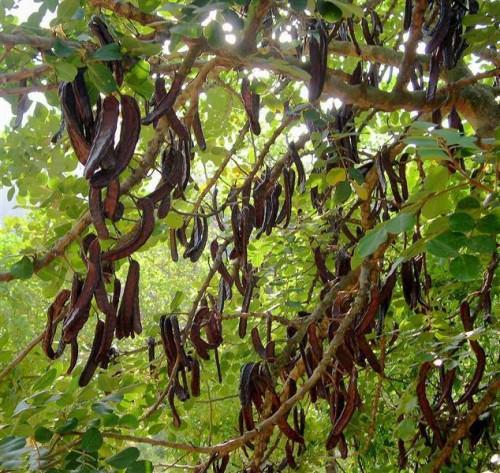
Once fully developed carob tree can withstand temperatures up to -7 ° C, but frost during flowering period can reduce or sometimes prevent fruiting. The tree is ideally grown in regions with a Mediterranean climate.
Fertilizer
Fertilizer is often unnecessary for carob trees. However, a 8-3-9 fertilizer can be applied occasionally to give plant a boost.
Pruning
Growing Carob is durable evergreen tree native to the Mediterranean. It has bright, green beautiful foliage, cluster of small flowers and edible pods that are used as cocoa powder substitute.
Carob pods contain about 8% protein, vitamins A and B and about one-third of calories than chocolate.

USDA Zones — 9-11
Propagation Method — Seeds
Difficulty — Easy
Soil pH — 6 – 8
Carob Tree Growing Conditions
Carob tree grows about 10 meter tall (exceptionally 15 m). It is a dioecious tree, which means each tree bears male or female flowers. Carob tree can bear up to 20 F temperature.
Carob tree has a thick and twisted trunk with a rough and brown bark. Its leaves are oval, dark green and shiny that are 12 to 30 centimeters long. Its foliage provides a welcome shade in hot countries. They form a very effective curtain against noise too.
Growing Carob from Seeds
The fresh carob tree seeds germinates quickly and easily. If you don’t find fresh seeds you can grow it from dry seeds which is scarified and soaked in water until they double in size. They can be planted in spring or fall.
Requirements for Growing Carob TreeSoil
The carob tree is a tree that grows in many soil types including hillsides with deep sandy soil or loam, even arid. It does not tolerate acidic or wet soils but requires good drainage.
Sun
Carob tree needs full sun and a position sheltered from wind.
Watering
It is resistant to drought. However, watering must be provided during dry seasons, especially if the tree is grown for its fruit.
Carob Tree Care

Once fully developed carob tree can withstand temperatures up to -7 ° C, but frost during flowering period can reduce or sometimes prevent fruiting. The tree is ideally grown in regions with a Mediterranean climate.
Fertilizer
Fertilizer is often unnecessary for carob trees. However, a 8-3-9 fertilizer can be applied occasionally to give plant a boost.
Pruning
0
0


